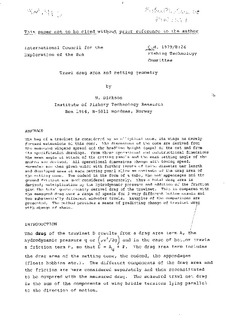| dc.contributor.author | Dickson, W. | |
| dc.date.accessioned | 2011-09-06T09:25:28Z | |
| dc.date.available | 2011-09-06T09:25:28Z | |
| dc.date.issued | 1979 | |
| dc.identifier.citation | This report is not to be quoted without prior consultation with the General Secretary. | en_US |
| dc.identifier.uri | http://hdl.handle.net/11250/103361 | |
| dc.description.abstract | The bag of a trawlnet is considered as an elliptical cone, its wings as merely
forward extensions of this cone. The dimensions of the cone are derived from
the measured wingend spread and the headline height (gape) of the net and from
its specification drawings. From these operational and constructional dimensions
the mean angle of attack of the netting panels and the mean setting angle of the
meshes are derived. All operational dimensions change with towing speed.
Formulae are then given which with further inputs of twine diameter bar length
and developed area of each netting panel allow an estimate of the drag area of
the netting cone. The codend in the form of a tube, the net appendages and the
ground friction are eachconsidered separately. Thus a total drag area is
derived; multiplication by the hydrodynamic pressure and addition of the friction
give the total geometrically derived drag of the trawlnet. This is compared with
the measured drag over a range of speeds for 3 very different bottom drawls and
two substantially different midwater trawls. Examples of the comparisons are
presented. The method provides a means of predicting change of trawlnet drag
with change of shape. | en_US |
| dc.language.iso | eng | en_US |
| dc.publisher | ICES | en_US |
| dc.relation.ispartofseries | ICES CM Documents;1979/B:26 | |
| dc.title | Trawl drag area and netting geometry | en_US |
| dc.type | Working paper | en_US |
| dc.subject.nsi | VDP::Agriculture and fishery disciplines: 900::Fisheries science: 920::Fisheries technology: 924 | en_US |
| dc.source.pagenumber | 11 s. | en_US |
